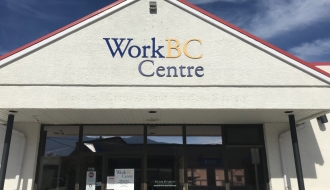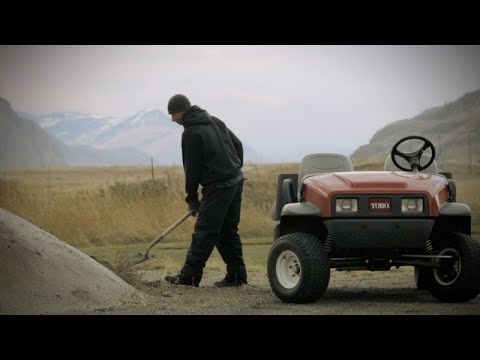Career Overview
Landscaping and grounds maintenance labourers assist with constructing landscapes and related structures.
The work of landscaping and grounds maintenance labourers includes maintaining:
- Lawns
- Gardens
- Athletic fields
- Golf courses
- Cemeteries
- Parks
- Landscaped interiors
People in this occupational group work for landscaping and lawn care companies, golf courses, cemeteries, as well as the landscaping operations of public works departments and private organizations.
Job Titles
Duties
Landscaping and grounds maintenance labourers perform some or all of the following duties:
- Spread top soil; lay sod; plant flowers, grass, shrubs and trees; and perform other duties to help with the construction of a landscape and related structures
- Cut, rake, fertilize and water lawns; weed gardens; prune shrubs and trees; and perform other maintenance duties as directed by supervisor
- Maintain lawns and grass along roadsides
- Operate and maintain power mowers, tractors, snowblowers, chain saws, electric clippers, sod cutters, pruning saws and other landscape maintenance equipment
- Spray and dust trees, shrubs, lawns and gardens, as directed, to control insects and disease
- Do other manual duties to clean and maintain landscaped environments
Earnings
Earnings is income that workers receive in exchange for their labour. Depending on the type of employment, earnings can be in the form of wages (hourly), salaries (fixed monthly or annual) or self-employed earnings.
Work Environment
# Workers Employed
18,285% Employed Full Time
25%Key aspects of the work in this occupational group:
- Work takes place outdoors in various weather conditions
- Workers may be exposed to chemicals such as pesticides
- Working with machinery and power tools can be a source of injury
Career Pathways
Progression to technical or supervisory occupations in landscaping and horticulture is possible with additional training or experience.
Related Careers
Occupational Interests
It’s important to understand what kinds of occupations align with your interests.
For more about occupational interests visit Skills for the Future Workforce > Characteristics.
Here are the top occupational interest(s) for this career profile:
Education, Training and Skills
- Some secondary school education may be required
- A provincial licence to apply chemical fertilizers, fungicides, herbicides and pesticides may be required
Education programs in B.C.

Skills
Every job calls for a certain set of skills. Knowing those skills is the first step in finding a good career fit.
Here, you will find the 10 most relevant workplace skills. Some are more important to achieving success in a certain career than others. These skills may come naturally to you or you may need to gain them through education, training and experience.
See the list of work-related skills below, ranked in order of importance for this career. Check out the list and see if this career matches your skills—take that first step!
Controlling operations of equipment or systems.
Using logic and reasoning to identify the strengths and weaknesses of alternative solutions, conclusions or approaches to problems.
Talking to others to share information effectively.
Adjusting actions in relation to others' actions.
Giving full attention to what other people are saying, taking time to understand the points being made, asking questions as appropriate, and not interrupting at inappropriate times.
Watching gauges, dials or other indicators to make sure that a machine is working properly.
Managing one’s own time and the time of others.
Considering the relative costs and benefits of potential actions to choose the most appropriate one.
Actively looking for ways to help people.
Being aware of others’ reactions and understanding why they react as they do.
Labour Market Statistics
Discover data, facts and information that have been gathered and analyzed. Learn about the characteristics of the economy and labour market in B.C.
Employment
Find out about employment types and trends by region and industry.
Employment
18,285Employment by Region







| Region | Employment | % Employment of this Occupation |
|---|---|---|
| Cariboo | 410 | 2.2% |
| Kootenay | 815 | 4.5% |
| Mainland/Southwest | 9,115 | 49.9% |
| North Coast and Nechako | 325 | 1.8% |
| Northeast | 210 | 1.1% |
| Thompson-Okanagan | 2,905 | 15.9% |
| Vancouver Island/Coast | 4,505 | 24.6% |
Labour Market Outlook
The B.C. Labour Market Outlook is a 10-year forecast of the expected supply and demand for labour in the province. It’s usually updated every year. The purpose is to provide British Columbians with the knowledge to make informed decisions on careers, skills training, education and hiring.
Forecasted Job Openings (2024-2034)
5,490Forecasted Job Openings
Forecasted Employment Growth Rate
Composition of Job Openings
Job Openings by Region (2024-2034)







| Region | Job Openings | Avg. Annual Employment Growth |
|---|---|---|
| Cariboo | 120 | 0.7% |
| Kootenay | 240 | 1.1% |
| Mainland/Southwest | 2,550 | 1.0% |
| North Coast and Nechako | 80 | 0.9% |
| Northeast | 50 | 1.1% |
| Thompson-Okanagan | 850 | 1.1% |
| Vancouver Island/Coast | 1,600 | 1.2% |
Industry Highlights
Learn about the opportunities in B.C.'s major industries, including employment trends, earning potential, locations of work and more.
Forecasted Job Openings by Industry
| Industry | Job Openings (2024-2034) |
|---|---|
| Business, Building and Other Support Services | 2,610 |
| Information, Culture and Recreation | 1,260 |
| Public Administration | 550 |
| Educational Services | 180 |
| Construction | 170 |
Resources
Resource information is currently not available.









